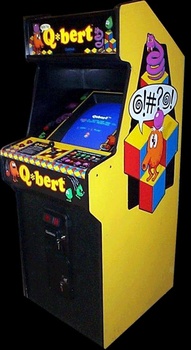| Q*bert | |
|---|---|
 Arcade cabinet | |
| Developer(s) | Gottlieb |
| Publisher(s) | Arcade Ports Parker Brothers Ultra Games (NES) |
| Designer(s) | Warren Davis Jeff Lee |
| Programmer(s) | Warren Davis |
| Artist(s) | Jeff Lee |
| Composer(s) | David Thiel |
| Platform(s) | Arcade, Atari 2600, Atari 5200, Atari 8-bit, ColecoVision, Commodore 64, Game Boy Color, MSX, VIC-20, Intellivision, NES, Odyssey 2, Mobile, SG-1000, Standalone tabletop, TI-99/4A, ZX Spectrum, Game Boy, Vidéoway |
| Release | October 18, 1982 |
| Genre(s) | Action, puzzle |
| Mode(s) | 1-2 players alternating turns |
Q*bert (/ˈkjuːbərt/ ) is an arcade video game developed and published for the North American market by Gottlieb in 1982. It is a 2D action game with puzzle elements that uses isometric graphics to create a pseudo-3D effect. The objective of each level in the game is to change every cube in a pyramid to a target color by making Q*bert, the on-screen character, hop on top of the cube while avoiding obstacles and enemies. Players use a joystick to control the character.
The game was conceived by Warren Davis and Jeff Lee. Lee designed the title character and original concept, which was further developed and implemented by Davis. Q*bert was developed under the project name Cubes.[2]
Q*bert was well-received in arcades and among critics. The game was Gottlieb's most successful video game and is among the most recognized brands from the golden age of arcade games. It has been ported to numerous platforms. The game's success resulted in sequels and the use of the character's likeness in merchandising, such as appearances on lunch boxes, toys, and an animated television show. The Q*bert character became known for his "swearing" and "Q*bertese sound" – an incoherent phrase made of synthesized speech generated by the sound chip and a speech balloon containing a grawlix that appears when he collides with an enemy.
Because the game was developed during the period when Columbia Pictures owned Gottlieb, the intellectual rights to Q*bert remained with Columbia, even after they divested themselves of Gottlieb's assets in 1984. Therefore, the rights have been owned by Sony Pictures Entertainment since its parent, Sony, acquired Columbia in 1989. Q*bert appeared in Disney's Wreck-It Ralph franchise, under license from Sony, and later appeared in the film Pixels.
- ^ "NES Games" (PDF). Nintendo of America. Archived from the original (PDF) on June 11, 2014. Retrieved August 9, 2015.
- ^ Cite error: The named reference
Retro54was invoked but never defined (see the help page).